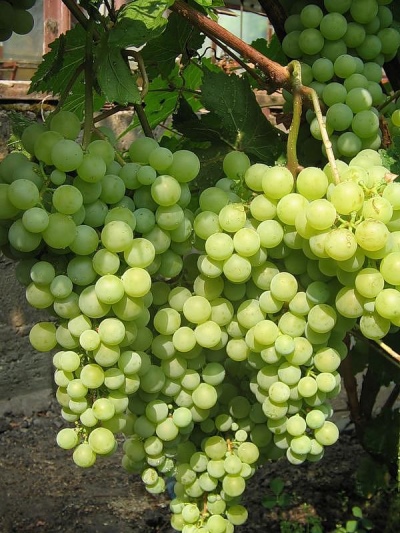
- Authors: Adolf Stark (Hungary)
- Appointment: dining room
- Berry color: yellowish green
- Taste: nutmeg
- With bones: Yes
- Ripening period: very early
- Ripening period, days: 113-115
- Frost resistance, ° C: -27
- Name synonyms: Pearls Saba, Beads, Hungarian early nutmeg, Perlina Saba, Pearl de Chaba, Perla chabanska, Csaba gyöngye, Yulski muscat
- Bunch weight, g: 117
A big mistake is the opinion that in Russia only those grape varieties are acceptable that have been developed by domestic breeders. With all the advantages of the domestic school, the developments of foreign specialists also deserve attention. And a vivid confirmation of this is the Pearl Sabo grape.
Breeding history
This culture was created at the height of the Cold War - more precisely, in the 1950s. It is known that Sabo Pearls were officially approved for use in 1959. The author of the variety is considered to be the Hungarian breeder Adolf Stark. The cultivar Bronnerstraube crossed with Muscat Ottonel was taken as a basis. Although the culture can no longer compete on equal terms with new varieties, it is worth disassembling it even due to one venerable age.
Description
Sabo Pearls are characterized by:
- an abundance of synonyms (Pearls Saba, Beads, Early Hungarian nutmeg, Perlina Saba, Pearl de Chaba, Perla Chabanska, Chaba Dende, Yulski Muscat);
- purely dining originally intended;
- universality of properties;
- early maturation;
- low (in comparison with newer developments of farmers) marketability of the crop.
Ripening period
It usually takes 113-115 days between the blooming of the buds and the attainment of ripeness of the berries. In unfavorable weather, this period may increase slightly. The approximate sum of active temperatures is 2087 degrees. All this allows the variety to be attributed to a very early group. Despite the already small interest for practitioners, this circumstance makes it attractive for experimenters.
Bunches
The Sabo Pearl Brush resembles a cone. Sometimes there are signs of the shape of both a cone and a cylinder. Grapes in bunches are grouped loosely or with medium density. The average weight of the hand is 0.117 kg. Peas should be feared.
Berries
Grapes of this variety:
- yellow-green;
- contain seeds (1-2 seeds per fruit);
- round, with a thin skin and tender juicy pulp;
- contain 0.14-0.18 kg of sugar per 1 cu. dm;
- received a tasting score of 7.6 points.
Taste
Szabo pearls have an attractive nutmeg flavor. But it still loses to newer types. The nutmeg aroma somewhat corrects the situation.
Yield
The share of grape-bearing shoots is 48%. The usual developed shoots have 0.56 inflorescences each. For those capable of producing crops - already 1.37. Normalization is required. The declared ability to produce from 50 to 120 centners per hectare.


Growing features
Sabo pearls:
- develops best on light loam or black soil;
- resistant to dry days, but prefers thoughtful irrigation;
- needs ventilation of the site.
Landing
Pits 60x50 cm are dug for this variety. The seedlings are kept in water for 48 hours so that they are sufficiently moistened. Then you need to dip them into a clay mash. Deepening the heel by 40 cm is required. The roots are spread carefully.

Pollination
Self-pollination is theoretically possible. In practice, it is more correct to plant the variety surrounded by several other bushes. Pollination improves the taste of the berries.
Pruning
Medium pruning is recommended. In the summer, there is also "green pruning". More often they take the pruner in spring and autumn. After the end of the growing season, a maximum of 8 eyes are left. At the same time, the crown of the bush is thinned out.



Frost resistance and the need for shelter
Sabo pearls usually retain their qualities at temperatures down to -27 degrees. Therefore, the vineyard tolerates frosty weather quite well. But it is better to foresee and anticipate all possible surprises.

Diseases and pests
The danger to the plant is represented by:
- powdery mildew;
- fusarium;
- fruit rot;
- oidium;
- lobe;
- moth;
- wasp attacks.

If a grape is exposed to any disease or insect, this always affects its appearance.
Storage
The high sugar content in combination with the thin skin of the berries is not the best combination. It is impossible to save the crop outside the refrigerators for any long time. You will either have to eat it quickly enough, or process it into juice, into wine.











































































